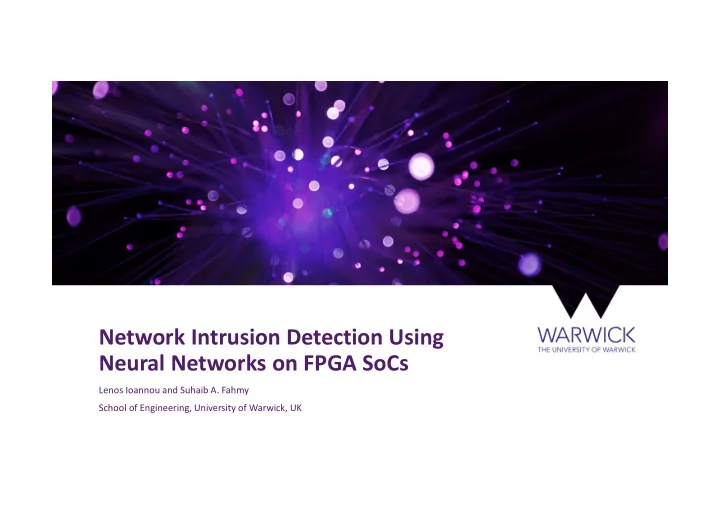

Network Intrusion Detection Using Neural Networks on FPGA SoCs Lenos Ioannou and Suhaib A. Fahmy School of Engineering, University of Warwick, UK
Introduction • Mainstream approaches in intrusion detection do not scale well to the embedded domain, mainly due to computational complexity • Limited computing power at the nodes, not intended for significant security mechanisms • More lightweight security mechanisms required, adaptable to updates • Explore the use Neural Networks as a more lightweight Network Intrusion Detection approach
Intrusion Detection Neural Network • NSL-KDD dataset: • Used 29 of the 41 features of each record (3 in categorical form) • 110 inputs after one-hot encoding • Trained a NN with 110-21-2, similar to that in [1], with Tensorflow [2] • Obtaining at best: Test set classification results • 96.02% accuracy on the train set • 80.52% accuracy on the test set
HLS Implementation • Vivado High Level Synthesis 2016.4, targeting a Xilinx Zynq Z-7020 • Use of memories as Look-Up-Tables, inputs restored to 29 • Use of floating point IEEE-754 to support coefficient updates • Configurable weights and biases through AXI-Lite (2375) : 2.3ms • Timing results: • Resource utilization:
FPGA System-Implemented System • Execution time-Test set: • Detection rate (IPv4 min-576B):
Conclusion • Network Intrusion Detection NN with moderate complexity • Flexible accelerator that adapts to newly trained weights dynamically • Offers fast detection rate, within a single packet Future work • Explore different and alternative network topologies • Extend our approach to other datasets • Explore approaches that reduce latency
References [1] B. Ingre and A. Yadav. Performance analysis of NSL-KDD dataset using ANN. In Proc. International Conference on Signal Processing and Communication Engineering Systems, pages 92–96, 2015. [2] Martin Abadi et al. TensorFlow: Large-scale machine learning on heterogeneous systems, 2015. [3] M. Idhammad, K. Afdel, and M. Belouch, “DoS detection method based on artificial neural networks,” International Journal of Advanced Computer Science and Applications, vol. 8, no. 4, 2017. [4] Mahbod Tavallaee, Ebrahim Bagheri, Wei Lu, and Ali A. Ghorbani. A detailed analysis of the KDD CUP 99 data set. In Proc. IEEE International Conference on Computational Intelligence for Security and Defense Applications, pages 53–58, 2009.
Recommend
More recommend